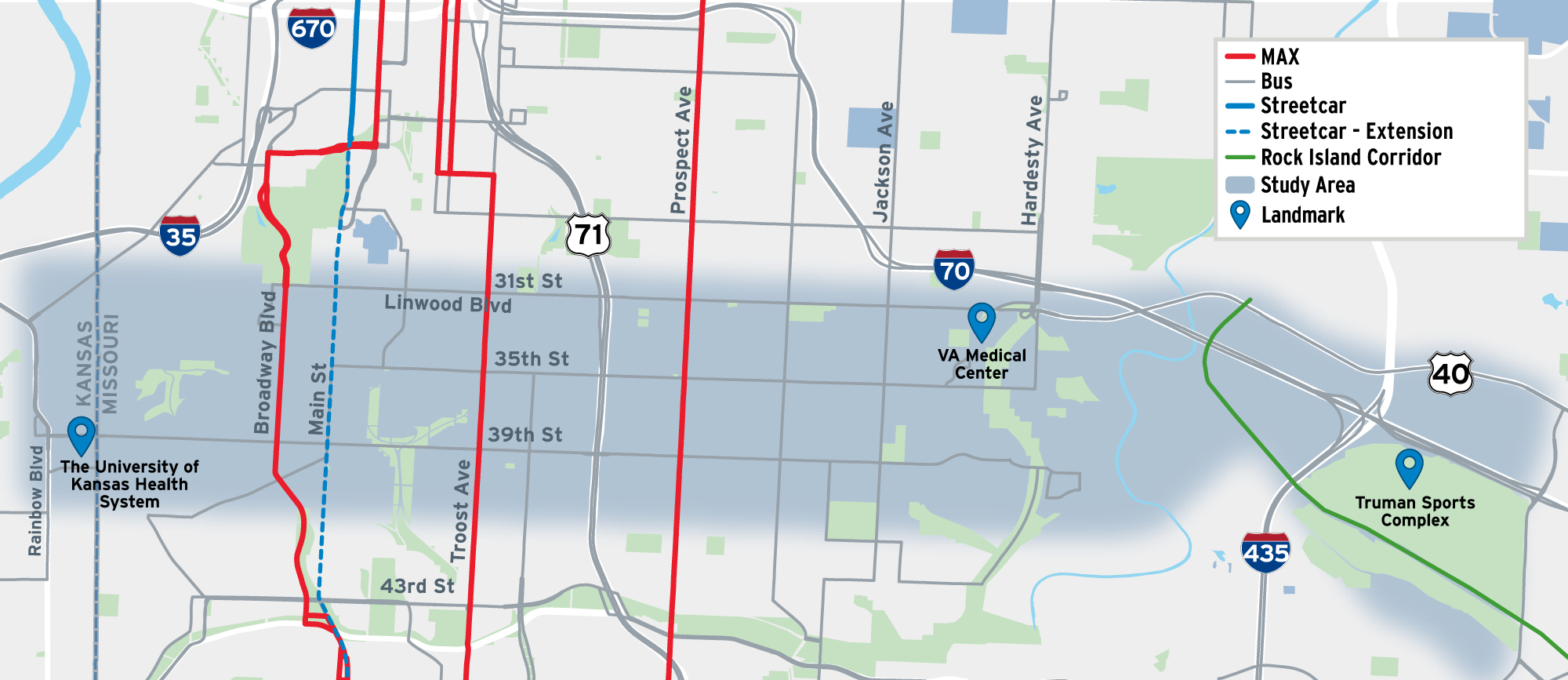East-West Transit Study
The vision for the East-West Corridor is to create a fast, efficient and attractive public transit service that aligns with existing Streetcar and MAX services. It will provide an east-west, high capacity transit connection between The University of Kansas Health System and a terminus on the east side of Kansas City, Mo. As an economic investment for the greater Kansas City area, the corridor would strengthen the RideKC transit network. After nearly two years of technical analysis and public engagement that began in 2022, the East-West study team continued planning design and public outreach efforts through the end of 2023 to refine the Recommended Alternative identified in early-2023. Through this effort, a draft Locally Preferred Alternative (LPA) was identified. The Executive Summary documents the efforts and outcomes of refining the Recommended Alternative into the draft Locally Preferred Alternative from July 2023 to January 2024.
Phase 1.5 East-West Transit Study Documents
Locally Preferred Alternatives Refinement: Financial Strategy Report
Locally Preferred Alternatives Refinement
Locally Preferred Alternatives Refinement: Westport Road Assessment
Phase 1 East-West Transit Study Final Documents
Alignment and Mode Screening Report
Cost and Financial Strategy Report
Recap for virtual public meeting held on November 9
Thank you to all who were able to attend the virtual public meeting on November 9, 2023! After nearly two years of technical analysis and public feedback, the RideKC East-West Transit Study team presented potential station locations along the proposed East-West corridor along 39th Street and Linwood Boulevard, between Rainbow Boulevard and Van Brunt Boulevard.The project has taken significant steps to move forward and your continued participation is needed to make it a success.
Virtual meeting recording
Public Meeting Presentation
Weigh in on potential station locations
You are invited to participate in the potential station location survey. Your feedback is needed to evaluate potential station locations.
Don’t delay! Complete the survey by 11:59 p.m. on Sunday, December 10, 2023.
More ways to engage
In case you were not able to join, the virtual public meeting video recording is linked above.
Additionally, the project team is available to provide the same presentation to neighborhood, community, and business groups in and around the study boundaries. If you’d like our team to come and present to your organization, please contact Alex Miller at alex@parsonkc.com or 816-601-0137.
February 2023 Public Meeting Resources
In case you missed it, the public meeting presentation from February 2023 is available below. Public feedback to weigh in on the two proposed transit scenarios, including routes and transit mode, was accepted until February 17, 2023. The survey is has closed. Thank you for your participation!
October 2022 Public Meeting Resources
Thank you to everyone who joined us at an in-person or virtual public meeting for the RideKC East-West Transit Study! In case you missed it, the virtual public meeting recording, resources and materials are available below. Your participation is critical to ensuring the needs of transit riders and the community are heard.
For this round of public engagement the deadline to submit comments has passed, but you can still view alignment options online. The online map displays alignment alternatives that are under evaluation, along with the criteria for which the alternatives are being evaluated. The project study area is divided into three segment alignments: west, middle, and east. Each segment alignment contains options for different routes.
What is the KCATA East-West Transit Study?
The Kansas City Area Transportation Authority (KCATA), in cooperation with several project partners, is evaluating an east-west, high-capacity transit connection between the The University of Kansas Health System and Rock Island Corridor/Truman Sports Complex (Kauffman Stadium and Arrowhead Stadium).
Who are the study partners?
For the study, the KCATA is working in conjunction with the Kansas City Streetcar Authority (KCSA); City of Kansas City, Missouri (KCMO); Jackson County, Missouri; Unified Government of Wyandotte County and Kansas City, Kansas (UG); and The University of Kansas Health System (KUHS).
Where are the study boundaries?

The general project study area is from Rainbow Boulevard to the west and the Truman Sports Complex to the east, and 31st Street to the north and 43rd Street to the south.
Why is this study being performed?
This study will provide a roadmap to help fill existing east-west transportation gaps, connecting into primary north-south transit corridors, as well as give communities in Wyandotte County and Eastern Jackson County the opportunity to leverage regional assets.
To the west, The University of Kansas Health System is an ever-growing medical campus that is a regional resource and employment hub. The high demand to access this area has also created a growing parking challenge, and stronger multimodal connections could help to mitigate the parking supply problem.
To the east is the Truman Sports Complex. Although recent developments have substantiated past claims of potential relocation of the Kansas City Royals, this is still a high priority area for increased transit access. Regardless of speculation around a downtown baseball stadium, this area continues to be a significant node for the region.
What makes the KCATA East-West Transit study different from past studies?
No recent study has analyzed feasibility of high-capacity connections to the streetcar spine and existing north-south MAX services crossing the state line between Kansas and Missouri. The extension of the streetcar south to 51st Street and Brookside Boulevard and north to the Berkley Riverfront makes an east-west connection much more impactful to areas on both sides of the streetcar spine. This study is necessary to examine the technical and financial feasibility of an east-west connection and will help determine next steps to make it a reality.
What corridors will be studied, specifically?
Previous studies have established the corridors below as possible high-capacity transit opportunities:
- Linwood Boulevard
- 31st Street
- Armour Boulevard/35th Street
- 39th Street
- 43rd Street
- U.S. 40 coming in north of the Truman Sports Complex
- Utilizing Stadium Drive through Leeds neighborhood
How can I participate in the KCATA East-West Transit Study?
- Survey: Periodic surveys eliciting public comment.
- Community presentations: The project team is eager to present to your community, neighborhood, business, or other group to answer questions and discuss the project. To submit a speaker request, please contact Alex Miller at alex@parsonkc.com or by phone at 816-601-0137.
- Public meetings
- Interactive map: Interactive map comment submissions are closed, but you can still view alignment options online.
Why should I participate in this study?
Your participation will help guide this study to build a regional transit system that will better connect the greater Kansas City region. Your feedback is critical to ensure the future of high-capacity transit in Kansas City is equitable, transformative and sustainable.
How long is the study?
This study started in April 2022 and will take approximately one year to complete.
Who is the study contact for more information?
For language translation options and more information about the East-West Transit study or to request a project team member at an upcoming meeting, please contact Alex Miller at alex@parsonkc.com or by phone at 816-601-0137.
